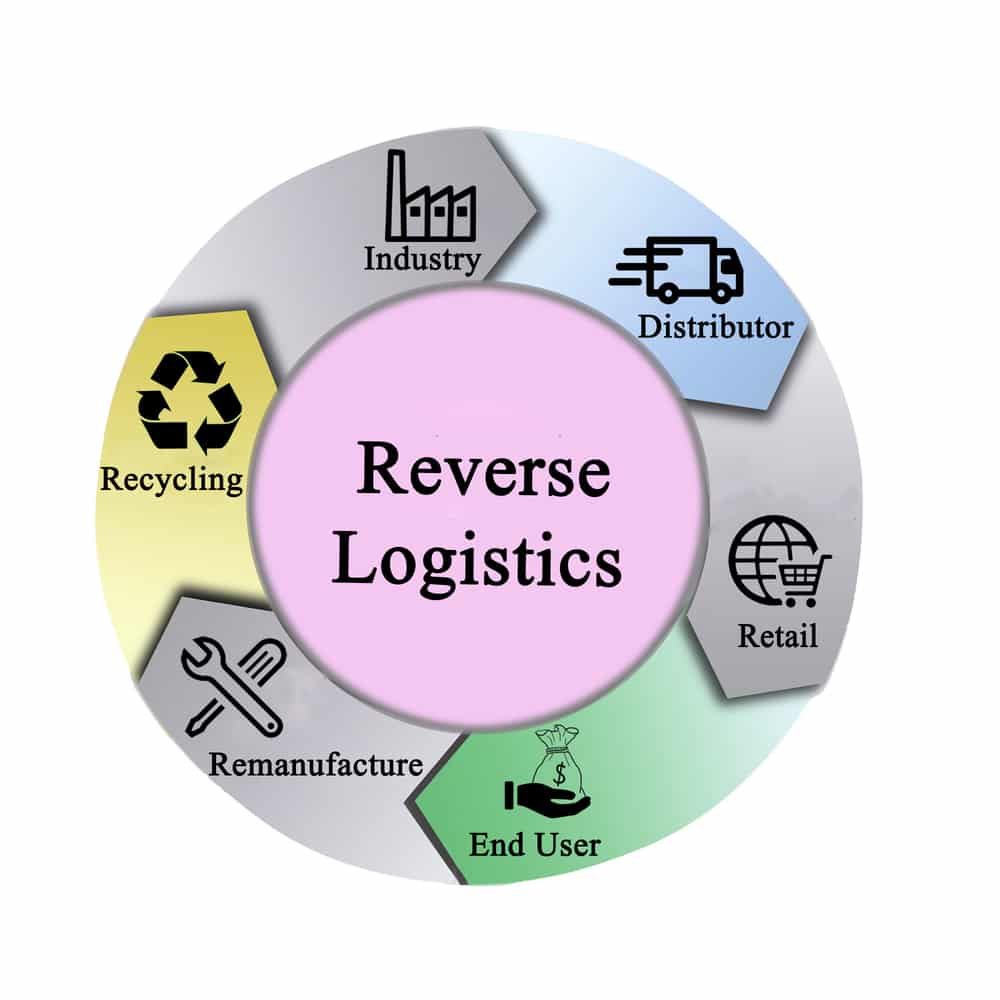Returns vs. Replacement: How Reverse Logistics Affect Processes

To outpace the competition, businesses must adopt processes to harness the reverse supply chain. In this way, companies can milk every bit of value in the return business stream.
The challenge that plagues many companies, however, is differentiating between – and establishing best practices for handling – returns versus replacements.
Although not every business model has the need for creating and maintaining separate processes for each of these categories, doing so may allow you to recover even more value. Reverse logistics automation solutions may be just what you need to make this happen quickly and easily.
What Is the Difference Between Returns & Replacements in Reverse Logistics?
Returns and replacements are two distinct processes that address different needs. Returns involve sending back a product to the retailer or manufacturer, usually due to dissatisfaction or defects, to receive a refund or credit. Replacements, on the other hand, entail exchanging a faulty or unsatisfactory product for a new or identical item. While both processes are integral to customer satisfaction, they serve different purposes and require separate handling and management strategies. Let’s explore the characteristics of replacement vs return.
Returns in Reverse Logistics as a Process
Returns are a critical process that allows customers to send back products that do not meet their expectations or are defective. This process involves several steps, including but not limited to:
- Receiving the returned item
- Inspecting its condition
- Processing the refund or credit
- Deciding on the item’s next action, such as restocking, refurbishing, or disposal.
Efficient management of returns is essential for maintaining customer trust and minimizing losses.
Replacement in Reverse Logistics as a Process
Replacement is a customer-centric process that exchanges a defective or unsatisfactory product with a different or identical one. Some steps involved in this process might include:
- Implementing a streamlined system for verifying the issue
- Authorizing the replacement
- Ensuring the swift delivery of the new item
Effective replacement strategies can enhance customer loyalty and reduce the likelihood of future returns.
When Should You Allow Returns & When Should You Allow Replacements?
Deciding when to allow returns versus replacements depends on various factors. These include:
- The nature of the product
- The reason for the return
- The company’s policies
Generally, returns should be allowed when customers are dissatisfied with their purchase due to preference, size, or other non-defect-related issues. This policy ensures customer satisfaction and maintains the flexibility of the return process.
On the other hand, replacements are more appropriate for defective or damaged products, where the customer still wants the item but needs a functioning version. Businesses must communicate their return and replacement policies, including any conditions or time limits, to prevent abuse of the system and ensure a smooth reverse logistics process. Ultimately, the goal is to balance customer satisfaction with operational efficiency and cost-effectiveness.
Establish a Strong Return Strategy & Process
Businesses must establish a strong return strategy and process to optimize the reverse logistics process. This process involves setting clear return policies, streamlining the return workflow, and leveraging technology to manage returns efficiently. A well-defined return strategy enhances the overall efficiency of the supply chain.
Consider the Cost of Returns
Returns can be costly for businesses. It’s crucial to consider some of the following costs when developing a return strategy.
- Shipping fees
- Restocking expenses
- Potential loss of revenue
Analyzing return data and identifying patterns helps companies implement measures to reduce return rates. Some examples include improving product quality or providing accurate product descriptions.
Properly Evaluate the Condition of a Returned Product
Evaluating a returned product’s condition is essential to determine its next action. Products in good condition can be restocked, while defective items may be repaired, refurbished, or recycled. Accurate assessment helps minimize waste and recover value from returned products.
Be Wary of Return Fraud
Return fraud, such as wardrobing or returning stolen goods, can significantly impact a business’s bottom line. Implementing strict return policies, requiring proof of purchase, and using technology to track return patterns can help mitigate the risk of fraudulent returns.
Avoid “Blind Returns” by Using a Returns Management System
Blind returns, where customers send back products without prior notification, can disrupt inventory management and logistics. A returns management system allows businesses to monitor returns in real time, providing visibility and control over the process. This system can also facilitate customer communication, ensuring a smoother return experience.
Why Is a Replacement Strategy Substantial?
Any business in a competitive market should put a lot of thought into its replacement strategy. A solid replacement strategy addresses immediate customer concerns. It also significantly affects long-term profitability, customer satisfaction, and brand reputation.
Profitability
Offering replacements for defective or unsatisfactory products can be more cost-effective than processing returns and refunds. Providing the replacement allows businesses to retain the sale and potentially reduce the costs associated with reverse logistics. Moreover, a streamlined replacement process can lead to more efficient inventory management and minimize the loss of revenue.
Customer Satisfaction
A hassle-free replacement process is a crucial driver of customer satisfaction. When customers know they can easily exchange a faulty product, they are more likely to trust and remain loyal to the brand. This positive experience can lead to repeat business and valuable word-of-mouth recommendations.
Brand Reputation
The way a company handles replacements can significantly impact its brand reputation. A transparent and customer-friendly replacement policy can enhance the brand’s image and differentiate it from competitors. Conversely, a cumbersome or unfair process can lead to negative reviews and damage the brand’s reputation.
How to Create a Replacement Strategy & Process
Creating an effective replacement strategy and process is essential for managing customer expectations and maintaining a smooth reverse logistics operation. Here are some critical steps to consider:
Understand Why Customers Need a Replacement Product
Analyzing the reasons behind replacement requests can help you tailor your strategy to address common issues. This understanding can lead to product improvements and better customer communication.
Create a Clear & Transparent Return and Replacement Policy for Customers
Your return policy should clearly outline:
- The conditions under which you offer replacements
- The process for requesting a replacement
- Any associated costs.
Transparency is critical to managing customer expectations and building trust.
Design and Define the Replacement Process
Establish a streamlined process for handling replacement requests, including verification of eligibility, authorization, and logistics for shipping the replacement product. Ensure the process is customer-friendly and efficient to protect the customer’s time.
Determine What You Will Do with Replaced Products
Decide whether replaced products will be repaired, refurbished, recycled, or disposed of. This decision should consider the product’s condition, cost-effectiveness, and environmental considerations. Reverse Logistics software can help you automate replacement options.
Ensure the Strategy Is Compliant with Laws & Regulations
Make sure your replacement strategy adheres to all relevant laws and regulations, including consumer protection laws and industry-specific regulations. Compliance is crucial to avoid legal issues and maintain your company’s positive reputation.
Continuously Review Your Replacement Strategy for Improvements
Regularly assess the effectiveness of your replacement strategy and make adjustments as needed. Consider feedback from customers and employees, changes in the market, and new technologies that could enhance the process.
How to Differentiate Between Replacement & Repairs
There are several factors to consider when deciding whether a product should be replaced or repaired. Here are some key elements to help differentiate between the two.
- Nature of the Issue: A repair might be more appropriate if the problem is minor and can be fixed easily. However, a replacement may be necessary if the issue is significant or the product is beyond repair.
- Cost-Effectiveness: Compare the cost of repairs to the cost of a replacement. If the repair costs are close to or exceed the value of a new product, replacement is a better option.
- Warranty and Guarantees: Another essential consideration is warranty returns. Some issues may be covered under warranty, making repairs more feasible.
- Product Lifespan: Consider the age and expected lifespan of the product. If it’s nearing the end of its useful life, a replacement might be more sensible.
- Customer Preference: Take into account the customer’s preference. Some may prefer a quick repair, while others might opt for a brand-new replacement.
Evaluating these factors helps businesses decide whether to repair or replace a product, ensuring customer satisfaction and cost efficiency.
How ReverseLogix Can Help You With Returns & Replacements
ReverseLogix is a comprehensive reverse logistics solution that streamlines and optimizes this process for businesses. These are the ways it can assist you with returns and replacements:
- Automated Returns Process: ReverseLogix automates the returns process, making it easier for customers to initiate returns and for businesses to manage them efficiently.
- Customizable Workflow: The platform allows you to customize the workflow according to your specific return and replacement policies, ensuring a seamless experience for your team and customers.
- Real-Time Visibility: With ReverseLogix, you get real-time visibility into the status of returns and replacements, enabling you to track progress and identify any bottlenecks.
- Data Analytics: The system provides valuable insights and analytics on return trends, helping you make informed decisions to reduce return rates and improve product quality.
- Integration Capabilities: ReverseLogix can integrate with your existing ERP, CRM, and e-commerce platforms, ensuring a smooth flow of information across your business operations.
- Compliance Management: The platform ensures that your return and replacement processes comply with relevant laws and regulations, reducing the risk of legal issues.
Leveraging ReverseLogix helps businesses enhance their returns and replacements process, improving customer satisfaction, reducing costs, and creating a more efficient reverse logistics operation. To see how ReverseLogix can transform your reverse business processes, contact us today to request a demo or view our pricing plans.
